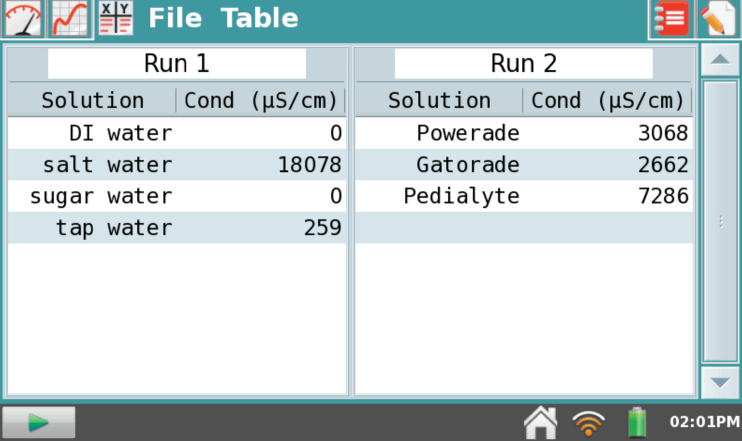Inquiry experiments can be designed to be carried out using everyday household items. In this experiment, students use common beverages to investigate the relationship between conductivity and electrolyte levels. The experiment uses a Conductivity Probe and LabQuest 2 for data collection and analysis.
Students begin the experiment by measuring the conductivity of distilled water. They add table salt to distilled water to measure the conductivity of a strong electrolyte, and then add sucrose to distilled water to measure the conductivity of a non-electrolyte. Lastly, students measure the conductivity of tap water; depending on the hardness of your local water, the conductivity of the tap water can vary greatly.
Upon completion of this preliminary activity, a discussion with students to develop researchable questions is important. If you choose the open inquiry method, you can encourage students to contribute their own researchable questions and hypotheses. We recommend that you provide the students with a list of supplies that are available to minimize unusual requests and encourage them to read the ingredient label when generating researchable questions. If you choose the guided inquiry approach, a list of researchable questions will be presented to the students. Sample data comparing the conductivities among the electrolyte drinks (Gatorade, Powerade®, Pedialyte®) are shown below.

After students have completed their experiment, bring the class together and share the results. This phase of the process encourages communication among the student groups and can lead to a better understanding of the topic.
This inquiry experiment was designed by Greg Dodd, a high school chemistry teacher from West Virginia with over 40 years of teaching experience. The Thirst Quenchers Inquiry Experiment is available as a Word® file that can easily be modified to fit your teaching environment.
Download Thirst Quenchers inquiry experiment
If you are looking for more inquiry-based experiments, our lab book, Investigating Chemistry through Inquiry, contains 25 experiments designed for inquiry-based learning.
